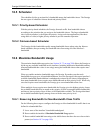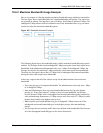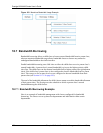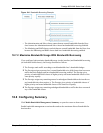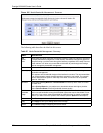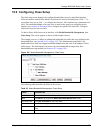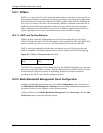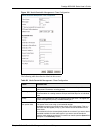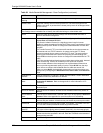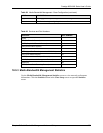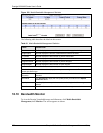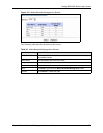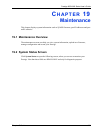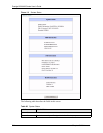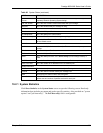
Prestige 660H/HW Series User’s Guide
205 Chapter 18 Media Bandwidth Management Advanced Setup
Enable DiffServ
Marking
Select this option to enable DiffServ marking on the Prestige.
DiffServ Mark Select the marking rule from the drop-down list. The first three digits are the
DiffServ code point. A packet with the lowest priority mark will be dropped when
the line is busy.
Bandwidth Filter
The Prestige uses a bandwidth filter to identify the traffic that belongs to a bandwidth class.
Active Select the check box to have the Prestige use this bandwidth filter when it
performs bandwidth management.
Service You can select a predefined service instead of configuring the Destination Port,
Source Port and Protocol ID fields.
SIP (Session Initiation Protocol) is a signaling protocol used in Internet
telephony, instant messaging and other VoIP (Voice over IP) applications. Select
SIP from the drop-down list box to configure this bandwidth filter for traffic that
uses SIP.
File Transfer Protocol (FTP) is an Internet file transfer service that operates on
the Internet and over TCP/IP networks. A system running the FTP server
accepts commands from a system running an FTP client. The service allows
users to send commands to the server for uploading and downloading files.
Select FTP from the drop-down list box to configure this bandwidth filter for FTP
traffic.
H.323 is a standard teleconferencing protocol suite that provides audio, data and
video conferencing. It allows for real-time point-to-point and multipoint
communication between client computers over a packet-based network that
does not provide a guaranteed quality of service. Select H.323 from the drop-
down list box to configure this bandwidth filter for traffic that uses H.323.
When you select None, the bandwidth class applies to all services unless you
specify one by configuring the Destination Port, Source Port and Protocol ID
fields.
Destination IP
Address
Enter the destination IP address in dotted decimal notation. A blank destination
IP address means any destination IP address.
Destination Subnet
Mask
Enter the destination subnet mask. This field is N/A if you do not specify a
Destination IP Address. Refer to the appendix for more information on IP
subnetting.
Destination Port Enter the port number of the destination. A blank destination port means any
destination port.
Source IP Address Enter the source IP address. A blank source IP address means any source IP
address.
Source Subnet
Mask
Enter the source subnet mask. This field is N/A if you do not specify a Source IP
Address. Refer to the appendix for more information on IP subnetting.
Source Port Enter the port number of the source. See the following table for some common
services and port numbers. A blank source port means any source port number.
Protocol ID Enter the protocol ID (service type) number, for example: 1 for ICMP, 6 for TCP
or 17 for UDP. A blank protocol ID means any protocol number.
TOS (Type of
Service)
TOS defines the DS(Differentiated Service) field in the IP header. Enter the new
TOS value of the outgoing packet (between 0 and 255). 0 is the lowest priority.
TOS Mask The ToS mask is used to compare the specified (or entire) bits in the ToS IP
header with the value specified in this rule. Enter the TOS Mask value between 0
(lowest priority) and 255.
Back Click Back to go to the main Media Bandwidth Management screen.
Table 59 Media Bandwidth Management: Class Configuration (continued)
LABEL DESCRIPTION



